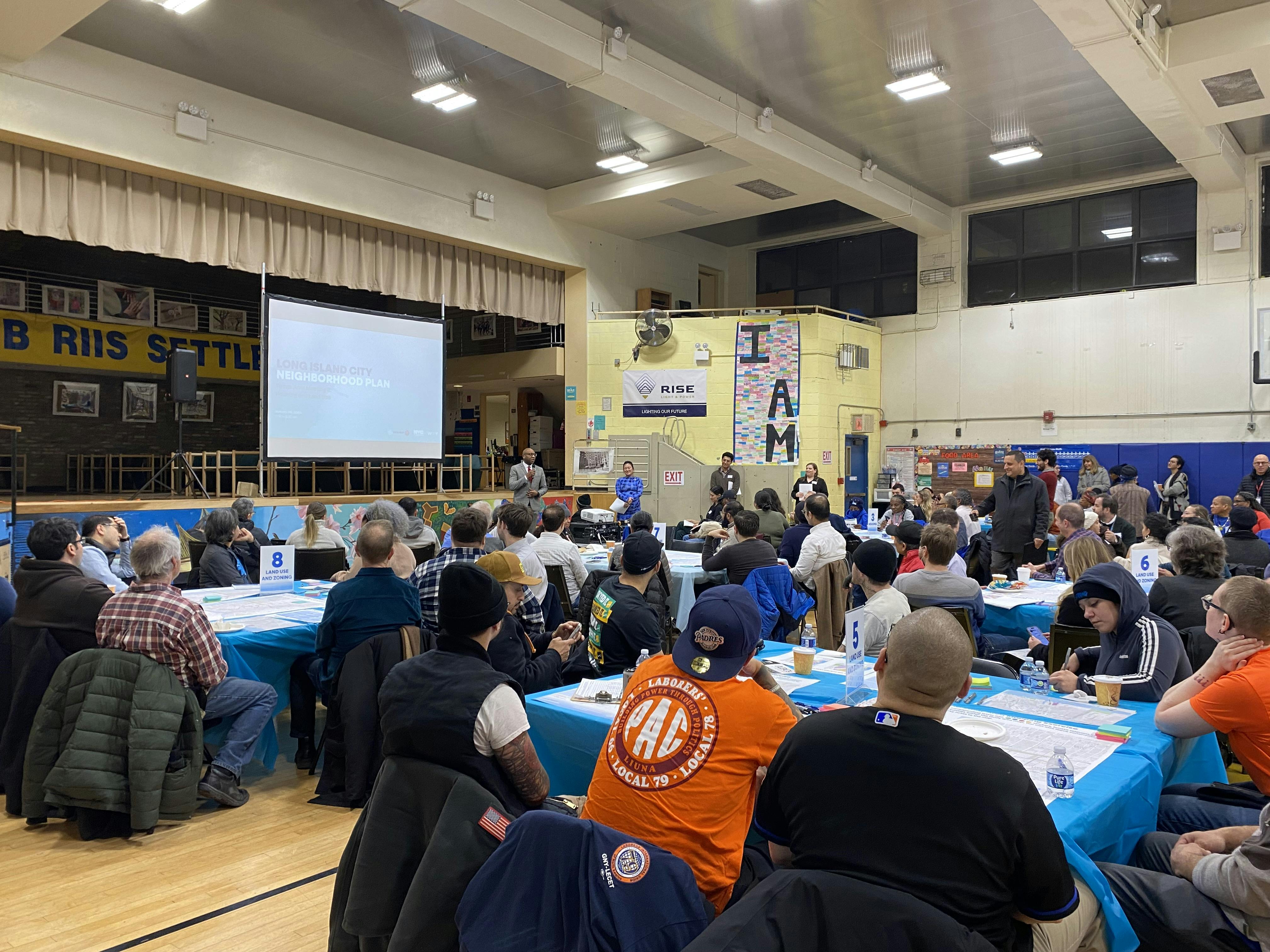What We Heard: Insights and Opportunities
We have taken an inventory of all the ideas and concerns and ideas that community stakeholders have shared that they want to see advanced through this planning process. These ideas were gathered from the Town Hall Kickoff event, 3 Focus Area meetings in December 2023, community events, through this website and by email and are being shared out during our 3 Focus Area meetings in January and February 2024. The synthesis of all of these Insights and Opportunities are summarized below, by theme:
Transportation and Mobility
Public Transportation
Greater regional transit connections and utilizing existing infrastructure for expanded transit services to connect to Metro-North, Amtrak, LIRR, and NJ Transit
Greater regional transit connections and utilizing existing infrastructure for expanded transit services to connect to Metro-North, Amtrak, LIRR, and NJ Transit
Bus stops lacking benches and shelters
The LIC ferry stop should be more accessible and routes can better connect
All subway stations should be made wheelchair accessible
Accessibility improvements near existing transit should be prioritized
Streetscape, Street Safety, and Biking
Create more pedestrianized spaces or open streets and car-free zones
Explore wayfinding, signage, and lighting opportunities
Create more protected bike lanes and greenways
Universal design standards should be advanced to improve accessibility and accommodate all users, and expand "all-ages-and-abilities" transportation infrastructure
Increase charging infrastructure for electric vehicles
Traffic, Parking and Driving
Reducing dependency on vehicles and parking is seen as a climate resilience measure
Maintain adequate parking capacity/permitting for residents/workers as the City advances effective curb management policies in support of land use
Repurpose parking spots for walking, biking, green space, stormwater collection, and improved resiliency
Deliveries and Logistics
Designated truck delivery drop off/pick up zones can improve pedestrian and bicyclist safety and business logistics
Delivery hubs can facilitate first/last-mile cargo bike deliveries and reduce large truck traffic
Freight deliveries can use maritime routes to limit trucks on the roads
Open Space, Parks, and Waterfront Access
Open Space and Parks
More street tree coverage and shading mechanisms are needed
Developers should be incentivized to contribute funding to parks and open spaces or build publicly accessible open space
Existing public spaces have reached their capacity (occupancy, permitting, etc.)
There are opportunities for partnering with park conservancies and public-private partnerships to produce more open space
There is potential for more active park uses to accommodate a growing community
Public Art and Beautification
- Temporary art activations and programming on public right of way, DOT property, and future development sites are well received
- Public art commission opportunities for local artists can support the creative community
Waterfront Access
- There is widespread support for a contiguous waterfront park along the extent of study area/context area
- There should be opportunities to get down to the water
- There is interest in a community boathouse and boat launch areas
- Facilities/programming along the waterfront can double as educational resources for the community
- Pedestrian bridges over Anable Basin and Newton Creek could ensure continuous greenspace/access
Public Safety
- Construction conditions over the next few decades should not significantly impact how livable and safe the neighborhood is for existing residents.
- “In between” spaces, particularly around and underneath infrastructure can be made safer
Climate Adaptation and Resilience
Coastal Resiliency
There is a need for an area-wide coastal flooding prevention strategy
The shoreline could serve as both a recreational asset and tool for coastal flood resiliency
There are concerns about how future high tides will affect the area
There is an interest in exploring soft barriers
Stormwater Management and Infrastructure
Localized flooding events occur during storms
Flooding is worsened by street configurations, construction barriers, and loading zones
The existing stormwater and sewage system can’t keep up with today’s development and intensifying flood events
Localized flooding events occur during storms
There is an interest in exploring opportunities for green infrastructure
Sustainability
Seek opportunities for renewable energy generation such as solar
Blackwater/wastewater cleaning should be required of local businesses and industry
Housing
Affordability/Housing
- More housing for families, multigenerational living is needed
Flexible live/work spaces are needed
Residents would like new housing with shared amenities
Resilient Housing Strategies
- Climate change and flooding issues should be addressed prior to building more housing
Property Ownership
- More pathways to home ownership should be identified and provided
Prioritize community land trusts and non-profit developers through funding, first priority for purchasing buildings, and exclusive rights to develop on public land
Public Housing
- New, public housing to guarantee deep affordability is needed
Channel more capital and programming funds to NYCHA through a rezoning
Land Use and Zoning
Building Height and Bulk
- Densifying can allow for a range of affordability levels, focusing on underutilized parcels, upzoning and/or adaptive reuse
If the waterfront allows for higher density, there should be a transition area to meet the contextual neighborhood scale
Explore height bonuses for developers to create more open space
Future Development and Real Estate
- Shoring up the capacity of new and existing infrastructure, transportation, and open space should be prioritized before building new housing
New housing provisions could meet advanced sustainability metrics, like net-zero carbon emissions and use renewable energy sources
New development and density should be focused around transportation nodes
Land Use, Manufacturing, Industry, and IBZ
- Create a more walkable, mixed-use neighborhood with active ground-floors
Preserve existing industrial land uses (IBZ)
Revisit IBZ rules to allow for residential alongside industrial uses and loosen restrictions of contextual zonings
Locals question the need for/interest in a rezoning
Economic and Workforce Development
Businesses and Employers
- Preserve existing small businesses and prevent displacement
- Match the level of investment in existing businesses with support for new industries
- Explore opportunities for additional commercial and green spaces on rooftops when suitable
Workers and Workforce Development
- Workforce training opportunities and small business funding for NYCHA and low-income residents/business owners in particular
- Opportunities to develop training and apprenticeship programs with existing businesses and organized labor in growing sectors
- More job opportunities and workforce training for applicants without college degrees are needed
Manufacturing, Industry and IBZ
- Maintain manufacturing facilities at affordable rates
- Developers and landowners can provide employment and space for growing/emerging industries—and should be held accountable
- Revisit IBZ rules to allow for live-work space and loosen restrictions of overly prescriptive
contextual zoning
Support and subsidize growing industries like green jobs and the film industry
Retail, Essential Services and Neighborhood Amenities
- Mixed-use development that allows for job creation alongside new housing
- Need for expanded commercial space and grocery stores
- Need for expanded transit capacity to improve local and regional connections for local businesses and workers
Partnerships
- Construction and maintenance of new resilient infrastructure can be leveraged to create local green jobs
- Food waste can be minimized by partnering local food/beverage businesses with shelters
- The presence of the creative community can be leveraged to develop an arts and performance district
Arts and Culture
Affordability/Preservation
- Maintaining artist spaces at affordable rates is a priority
- There is interest in maintaining the industrial fabric of the neighborhood as it has fostered the creative community
- Allow for artist live-work spaces
Partnerships
- Locals support the creation of new venues, studio spaces, and other artist live/work spaces
- Incentives for private developers and small businesses to partner with the local creative community are needed
- The location/colocation of ancillary resources/facilities for creative industries (e.g. sound stages, arts supply stores) should be encouraged
- Opportunities for developers and landowners to provide employment opportunities and space for growing/emerging industries are needed
Public Art and Beautification
- Expand the use of outdoor spaces for creative uses (e.g. murals, sculptures, performance venues)
Community Resources
Community and Youth Programs, Healthcare and Social Services
- Interest in community center with sustainable funding mechanisms
- Need for expanded healthcare facilities
City Services (non-education)
- Need for expanded facilities with affordable recreation and workout equipment/classes, in particular a new pool
- Need for more youth programs
- Need for more senior programs
Public Land/Buildings, Community Benefits
- Interest in programming open spaces to complement local school needs (e.g. track, soccer field)
- Support for locating community resources on publicly-owned land along the waterfront
- Locals want developers to contribute funding for new community resources and schools
Schools, Libraries and Education Resources
- Need for increased safety along school commutes/ identify designated routes
- Need for enough school capacity so students can remain in LIC from elementary through high school







